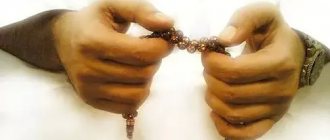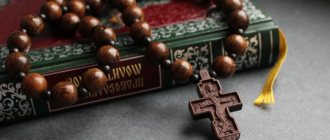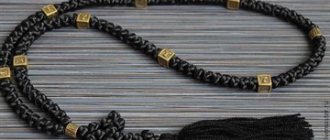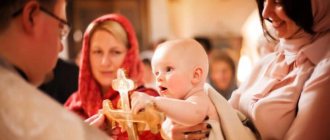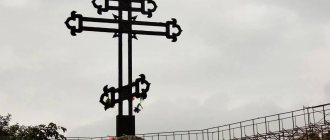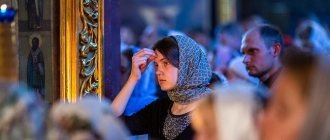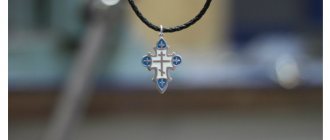Lestovka is a type of rosary, a type of rope, widespread in Ancient Rus' and preserved in the everyday life of Old Believers. It is a woven leather (or, in later times, rag or leatherette) tape sewn in the form of a loop. It symbolizes both the ladder (ladder) of spiritual ascent from earth to heaven and a closed circle, an image of eternal and unceasing prayer. A ladder is used to make it easier to count prayers and bows, allowing you to focus on the prayers.
In addition to the usual 109-step ladder, there are 150-step ladders, the so-called. "Virgin's Ladders" They are of later origin and are made in the image of a Catholic rosary. In the Old Believers they have minimal distribution. The production and artistic decoration of ladders was and remains one of the traditional Old Believer crafts. Monastic work was especially famous.
Design and symbolism of the ladder
The device of the ladder meets the practical needs of worship (for example, when saying prayers 40 or 12 times), but at the same time it has a symbolic interpretation. There are 100 simple steps on the tape, called bobs. In addition, there are three more steps at the beginning, three at the end and three “great” steps in the middle, which collectively mean the nine ranks of angels . The beginning and end of the ladder are marked by intervals without steps, symbolizing heaven and earth . The “great” steps divide the staircase into four unequal sections: from the “ground” to the first great step - 12 steps, which means 12 apostles . From the first great step to the second inclusive - 40 steps. This means a 40-day fast of the Lord Jesus Christ . There are 33 steps to the third great step, meaning 33 years of the Lord’s earthly life . After the third great step and up to “heaven” there are 17 simple steps, meaning 17 Old Testament prophecies about Christ . At the junction of the ends of the ribbon, four edged triangular “lapostki” (laposka, sometimes palms) are sewn, which are often decorated with beads and embroidery. They mean the four evangelists , and the border is the gospel teaching . Under the paws there are slides - seven rectangles strung on a ribbon, according to the number of seven church sacraments . These movements also mean seven complete lestovkas, which every pious Christian must pray during the day. This practical significance of the movements - counting the number of sanded flaps - is absent in products of modern work, since the movements are made only symbolically, and the legs are often so tightly sewn together that the movements are difficult to reach.
The use of lestovka (or rope) was first established in the Church in the 4th century by Saint Basil the Great in the monasteries he founded. The monks of these monasteries, out of their love for God, performed the prayer rule established by Saint Basil every day according to the church books. However, among these ascetics there were illiterate people, and for them, praying from a book was replaced by performing a certain number of the most important and at the same time simplest prayer: “Lord Jesus Christ, Son of God, have mercy on me, a sinner” - the Jesus Prayer. It was established to pray six thousand of these prayers for the entire Psalter, six hundred for the Midnight Office, one thousand five hundred for Matins, and so on. For more information on this, see the book “Charter on Christian Living” (as well as in the books “Saints of the Holy Orders”, “Small Home Rule”, “Prayer Book” of the modern edition).
For the correct counting of prayers, Basil the Great introduced the first ladder into use by monks, or rather, a rope - a small rope loop on which one hundred and three knots were tied (for the number of knots, see the old printed Nomocanon for the Great Potrebnik, l. 30). Over time, the rope began to be used not only by the illiterate, but also by all monks in general, as well as pious laymen, and not only for counting prayers, but also for the constant invocation of the name of God. By the time of the Baptism of Rus' (by the 10th century after the Birth of Christ), a firm concept had developed in the ancient Greek Church that the constant performance of the Jesus Prayer with the help of a rope, in every place, is a necessary part of Christian life.
Having adopted this concept together with the Orthodox faith and keeping it unchanged for many centuries, Ancient Rus' somewhat modified the Byzantine rope: by the seventeenth century it was decorated, enriched and turned into a ladder, to the direct description of which we now proceed. So, the lestovka has four triangular (in honor of the Holy Trinity) paws, sewn in pairs, which mean the four evangelists. The sheathing around the paws is a gospel teaching. Inside, between the upper paws, seven small patches (movements) are sewn as a sign of the seven Church Sacraments. Let us list them as a reminder: 1) Baptism; 2) Confirmation; 3) Priesthood; 4) Eucharist (i.e. Communion); 5) Confession (Repentance); 6) Marriage; 7) Blessing of Anointing (Unction). Where the ladder is connected, that is, above the upper legs, there are three steps (or bob) on both sides. The ladder itself has three more large steps, and all these steps together make up the number nine - in honor of the nine ranks of angels. The remaining steps of the ladder are smaller, their number is one hundred. Thus, the number of steps commanded by Saint Basil - one hundred and three - is preserved (if you do not take into account the six steps at the top of the paws).
Like any ladder, this prayer “ladder” has a beginning: an empty place without steps, called “ground”, after which there are twelve small steps - in honor of the twelve apostles of Christ. Then, after the first big step, thirty-eight small steps - in honor of the thirty-eight weeks and two days during which the Most Holy Theotokos carried the Child Christ in her womb. After the second large step, which means, as it were, half the path traversed in prayer, thirty-three small steps follow - in honor of the thirty-three years of the earthly life of the Lord Jesus Christ, and then, after the last big step, another seventeen small ones, meaning the number of Old Testament prophecies about the Savior. After these last steps there is an empty space called "sky".
As already indicated above, the ladder is an auxiliary device for unceasing prayer, therefore pious Christians always have it with them, no matter where they are. It is customary to hold the ladder in your left hand, moving through its “steps” from “earth” to “heaven”, at each “step” making a prayer to Isusov, so that the mind does not relax and thoughts do not wander anywhere, but focus on the Divine. In this case, the fingers of the left hand are folded in the same way as the fingers of the right to make the sign of the cross.
usage
If someone is unable to attend church services for some reason, it is considered commendable to pray on the ladder, using several repetitions of the prayer. The Jesus Prayer combined with specific bows and prostrations.
When using a ladder as part of a prayer rule, three counters at each end are used for the following prayers (accompanied by bows) at the end and beginning of a prayer session:
God, be merciful to me, a sinner.
(sinner, if a woman) Create me, Lord, have mercy on me. Without number of sinners, Lord, forgive me. God, be merciful to me, a sinner. ( bow
) You created me;
Lord, have mercy on me. ( bow
) I have sinned immeasurably;
Lord, forgive me. ( bow
) Some say in the last line “have mercy and forgive me a sinner / sinner” (have mercy and forgive me a sinner) instead of “forgive me” (forgive me).
The remaining one hundred small counters are used to repeat the Jesus Prayer, with bows and prostrations.
Other uses of the ladder include counting twelve or forty repetitions of Lord, have mercy, used as responses to the Divine Liturgy and the Canonical Hours. Seventeen counters are also used to count the number of prostrations during the Prayer of St. Ephraim.
On Lesovka with 150 steps, prayers are read to the Virgin Mary.
Outside the Old Believers
Prayers written on scrolls in Lestovka
Lestovka is often found outside communities that adhere to the liturgical practices of the Old Believers. Eastern Catholic and Eastern Orthodox Christians who know the Slavic traditions of the Byzantine Rite love to own and use them. Members of the Russian Orthodox Church today increasingly use Lestovka. Examples of Russian Orthodox saints depicted with a ladder: St. Seraphim of Sarov, [1] Sergius of Radonezh, Kiev-Pechersk saints and many other saints of the Russian Orthodox Church.
How many beads are there in Orthodox rosaries?
Orthodox rosaries can have a different number of beads. The smallest number is 10 grains, the largest is 1000. A characteristic feature of rosaries in Orthodoxy is their multiple of ten.
The number of beads has a direct connection with a certain significant event in the history of Christianity.
There are rosary beads with a fixed number of beans, which are in demand among Christians.
The ring rosary consists of 10 beads. Soutache, wool, natural stones, leather are materials that are often used to make this attribute. The grains are quite small: their diameter ranges from 6 to 11 mm. Finger rosaries have a round shape with a cross, which is worn on the index finger. The 10 beads represent the 10 commandments of God received by Moses on Mount Sinai.
If short prayer rules are being performed, then a rosary with 20 beads is best suited. The first ten grains are divided with the other ten through a small cross. Sometimes a different size bead serves as a separator. The rosary can also be decorated with a tassel. The materials used to create the attribute are the same: precious stones, wood, thick leather, wool. Why they began to make rosaries with so many beads is not entirely known, because the number 20 does not have any sacred meaning in Christian traditions.
In Orthodox rosaries with 30 grains, each ten is separated by special beads or a cross, and tassels also complement this product. Traditionally, you can find rosary beads made of soutache, leather, stone, and wool. If we talk about symbolization, we usually refer to the fact that Jesus, being a man, began His ministry at the age of 30.
The rosary, consisting of 33 grains, was created in memory of the earthly years of the Lord Christ. Such rosaries are arranged as follows: 33 grains close the rosary into a circle thanks to three additional beads, a cross or a tassel.
Orthodox rosary made of 40 grains are dedicated to the forty-day fast of Jesus in the desert. Popular materials for creating rosaries are wood, soutache, wool, and stones. An interesting fact is that leather rosaries with so many beads are not found. The beads can either be closed in a perfect circle, or connected with a cross or tassel.
Rosaries consisting of 50 grains are also very popular among believers. The history of the creation of rosaries is different. Some claim that they are dedicated to the memory of the Descent of the Holy Spirit on the Apostles (the Feast of Pentecost is one of the greatest Christian holidays; in Russia it is known as the Day of the Holy Trinity). Others believe that the number “50” refers to Psalm 50, which begins with the words “Have mercy on me, O God, according to Your great mercy...”.
There are rosaries made of 70 beads, but they are extremely rare. This number was chosen in memory of the 70 apostles called by Jesus Christ to serve.
One of the most popular options are products made from 100 grains. They are also called “monastic centurion” in another way. Used daily for prayer rules. For their use by the laity, it is advisable to obtain a blessing from a priest. The appearance of the rosary has the shape of a circle. Each ten is divided by a cross. Juniper, soutache, wood or wool are decorated with a decorative tassel.
Old Believer rosaries, known as lestovki, consist of 109 beans. More details about them are written above.
The rosary in honor of the Virgin Mary includes 150 units. Such rosaries are designed to read 150 prayers, among which the Theotokos rule is often recited. The revered Saint Seraphim of Sarov spoke about the usefulness of the prayer read 150 times during the passage of the Holy Kanavka in the Diveyevo Monastery, which the Mother of God herself passed through.
“Athos Three Hundreds” is another type of rosary used for prayer rules. They, as you can guess from the name, consist of 300. They were widely used in Greek and Athos monasteries. In Russia, such rosaries are mainly used by monks. The standard materials used for their production are soutache or wool.
Rosary beads with 500 or 1000 grains are common among monks. The products are usually made from soutache or wool. The main purpose is to read prayers daily. They are practically not used by the laity, so finding them is quite problematic.
